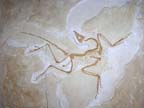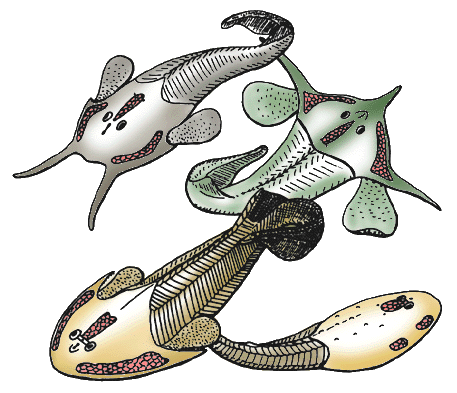 |
 |
 |
 |
 |
Produced
by the Population Genetics and Evolution class, Furman University |
||||
 |
 |
 |
 |
 |
Produced
by the Population Genetics and Evolution class, Furman University |
||||
 |
The
Silurian: Osteostracans |
 |
||
| Osteostraci,
or cephalaspid (meaning ‘headshields’), is a major clade containing
more than 200 species of fossils discovered all over the Northern Hemisphere
(Janvier 1997). Osteostracans lived in the Early Silurian era, about 430
million years ago, until the late Devonian era, about 370 million years
ago. They were armored, jawless fishes which lived in mainly marine waters,
but were also found in fresh water environments. They had horsehoe-shaped
heads that contained odd “fields” on the top and sides; perhaps
used as sense organs. Paleontologists debate whether these ‘fields’
were used to detect other organisms in the water by vibrations or if these
sense organs were used to send out electric currents to help guide them
in murky water (White and Kazlev 2010). Having a flat head and body, Osteostracans
were most likely benthic feeders, but their padded fins also allowed them
to be fairly agile swimmers (Wikipedia 2010). The osteostraci were the
first fossil jawless fishes known whose internal anatomy has been described
in great detail, as pure bone covered many of the internal organs, including
the brain, veins, and nervous system (Janvier 1997). The brain of osteostracans
is very similar to the brain of the modern lamprey, another jawless fish.
However, the Osteostraci have many synapomorphies with jawed fish, including
true bone, an epicercal tail, and a dorsal jugular vein (White and Kazlev,
2010), and are thought to be the sister group to the jawed vertebrates
(Janvier 1997). Page by Julia Bobo |
 |
| Osteostracans. photo from Tree of Life Project | |
|
Janvier P. 1997. Osteostraci. Tree of Life Project. Accessed February 15, 2010. White T, Kazlev MA. 2010. Thelodonti: Osteostraci. www.palaeos.com. Accessed February 15, 2010. Wikipedia. 2010. Osteostraci. Accessed Feb19, 2010. |